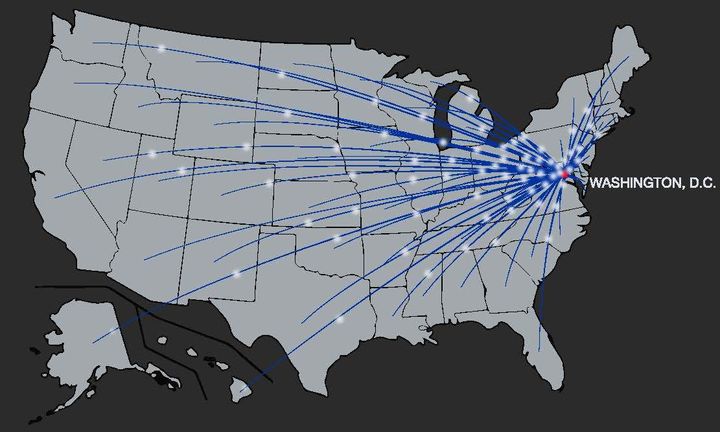
by Ryan Maher, University of Chicago Law School Class of 2018
“Sixteen shots” was repeated in chant, with the brandishing of signs reading the same, as protesters took to the streets of Chicago. Heads were shaken in sadness and disbelief at the fact that Chicago youth Laquan McDonald was shot sixteen times by police, though he fell to the ground with the first shots.
Protest and demands for change arose not just from the killing itself, but also from the tragic magnitude of the violence.
But is sixteen shots a lot compared to other police shootings? It seemed like a firestorm when I first heard about it, and appeared even more excessive when I watched footage of the incident.
Police use force every day in the United States to maintain order and ensure compliance with the law. Whether it be a stern verbal warning, threat of arrest, use of a taser, or the discharge of a firearm, officers apply pressure to deter law-breaking or apprehend perpetrators.
It’s clear that officers must be permitted to apply some amount of force to police effectively. But the degree or kind of force available to an officer in any given situation runs along a spectrum. Tenets of justice and equality demand that every effort be applied to strike the right balance along that fine-lined spectrum; that unnecessary or excessive force is never used by police officers.
So what is a “normal” amount of shots fired at a subject? As a student in the International Human Rights Clinic at the University of Chicago Law School, I was involved in a project gathering and analyzing use of force by police in selected cities in the United States. It turns out that, while sixteen shots fired at one subject is higher than normal, it is not such an outlier.
Our study on police use of force did not come by this information easily. We spent over a year and a half collecting data from fewer than two dozen police departments, and still failed to obtain all of the statistics we set out to gather. Such important data should be systematically collected, centralized, and accessible. The difficulty we experienced in obtaining information about parameters like the number of shots fired by an officer at a human subject shows the urgent need for improved data collection, like that offered by the National Use of Force Data Collection Program.
The National Use of Force Data Collection Program
Among the numerous reforms that could be implemented to limit police use of force to its reasonable minimum is the DOJ and FBI’s National Use-of-Force Data Collection Program. The program will be administered by the Uniform Crime Reporting division of the FBI. Law enforcement agencies across the country will submit data on a variety of uses of force, ideally including all uses of tasers and firearms, to an easily-accessible, centralized collection. The reporting procedures used by agencies will also be evaluated to ensure agency accountability. The project will compile the information necessary to identify the causes of excessive or discriminatory uses of force by police officers.
The six-month pilot study for the program began on July 1, 2017, and will conclude on December 31, 2017. The first releases of information through the program will begin after the conclusion of the pilot study. During this study period, the FBI and DOJ are studying reporting techniques, ensuring data accuracy, and recruiting law enforcement agencies to participate in the program. To this last point, it is important to note that participation in the program is entirely voluntary, as neither the FBI nor the DOJ possess the authority to require this kind of data sharing from local law enforcement units. However, many law enforcement agencies have already expressed their commitment to the program.
At present, data on the use of force, including the number of shooting or taser incidents and fatalities, is sometimes obtainable from police departments, but only for those with the time and resources to initiate the months or years-long FOIA process on a department-by-department basis. With almost 18,000 state and local law enforcement agencies in the United States, piecing together a comprehensive picture of how force is used nationally is a Sisyphean feat for even the best-equipped organization.
As was mentioned above, our team at the University of Chicago Law School faced substantial obstacles in our data collection efforts. It took our group over a year and a half to obtain data on the number of shots fired by officers, targeting fewer than two dozen departments. Among the challenges faced were resistance on the part of information officers to facilitate our requests, prolonged timelines for data delivery, and, in a couple instances, delivery of the wrong data altogether.
During the open comment period on the National Use-of-Force Data Collection Program, the IHRC submitted comments jointly with Amnesty International regarding the types of information that should be tracked by the program (see comments here). To highlight a few of our recommendations: we advised increasing the incorporation of international standards delineating the appropriate use of force, ensuring that a wide range of demographic descriptors of subjects fired at by officers are captured, and including data on the usage of tasers.
What happens under President Trump?
As with many other federal programs, uncertainty abounds as to the implications of the Trump administration. Both President Trump and Attorney General Sessions are on record as opposing ongoing police reforms. (See a summary of Trump’s positions on criminal reform here, and Sessions’ here.) Moreover, Sessions voted against the reinstatement of funding for the COPS program, a DOJ effort that works to improve police-community relations, primarily through an information-sharing program. But at present, the signs point toward optimism. The program is moving ahead as planned and the pilot study is on schedule.
Problems may also arise from the voluntary nature of the program for state and local agencies. Neither the DOJ nor the FBI can directly require police departments to report on any uses of force. This raises serious concerns about the consistency and quality of reporting, especially in an environment already hostile to police reforms.
Moreover, the DOJ does not have a great track record for implementation of programs like this. The Death in Custody Reporting Act, which tracks civilian deaths resulting from interactions with law enforcement, has a record of non-compliance by states. This is especially concerning because DiCRA authorizes the DOJ to penalize non-complying states through a reduction in grant funding. There is no companion penal mechanism in the National Use of Force Data Collection Program.
By making information about how police use force in the United States readily accessible, government agencies and private groups can work towards understanding and remediating the causes of excessive force. To ensure the National Use of Force Data Collection Program is implemented, and implemented robustly, those concerned should keep abreast of developments related to the program, and to criminal justice reform generally. Phone calls to Senators and Representatives, as well as assistance to those NGOs working for criminal justice reform, can aid in the fight for this critical information.
The tragedy and injustice of events like the death of Laquan McDonald urgently call for redress. Deadly force should never be used where non-lethal force would suffice. Holding the police strictly accountable for the magnitude of force they apply is one step among many that need to be taken to reform policing in the United States.
